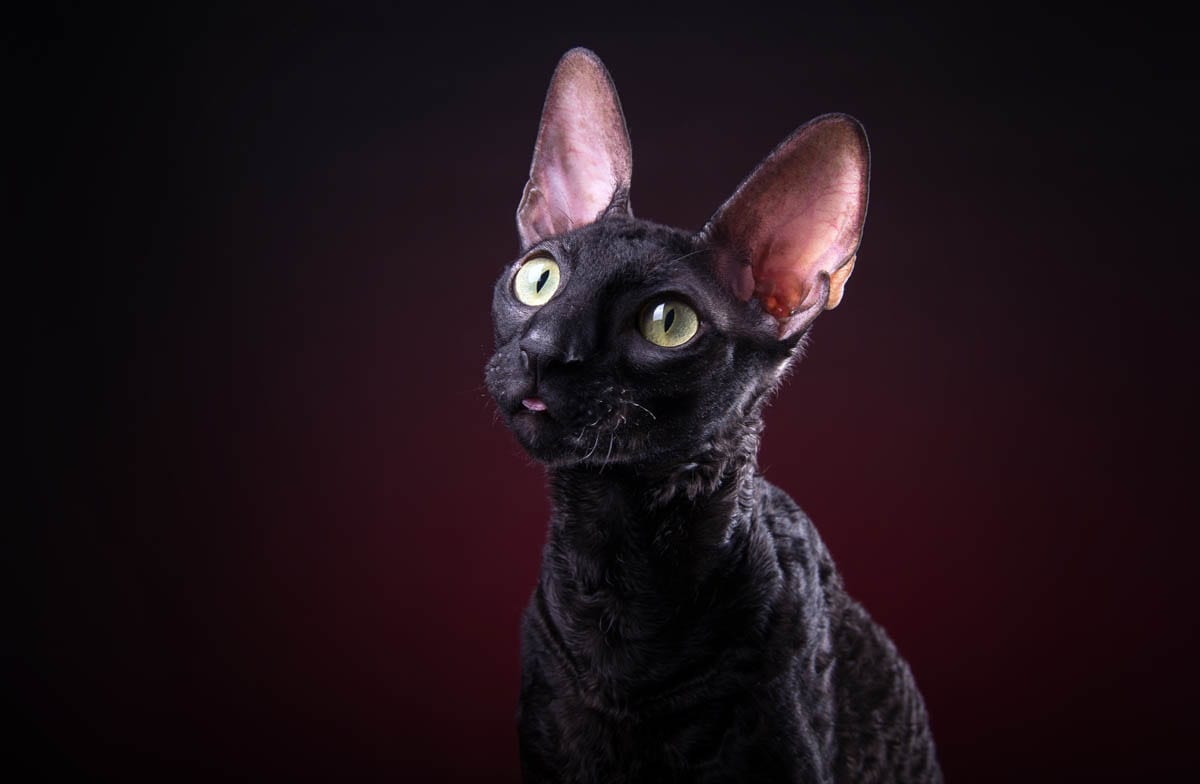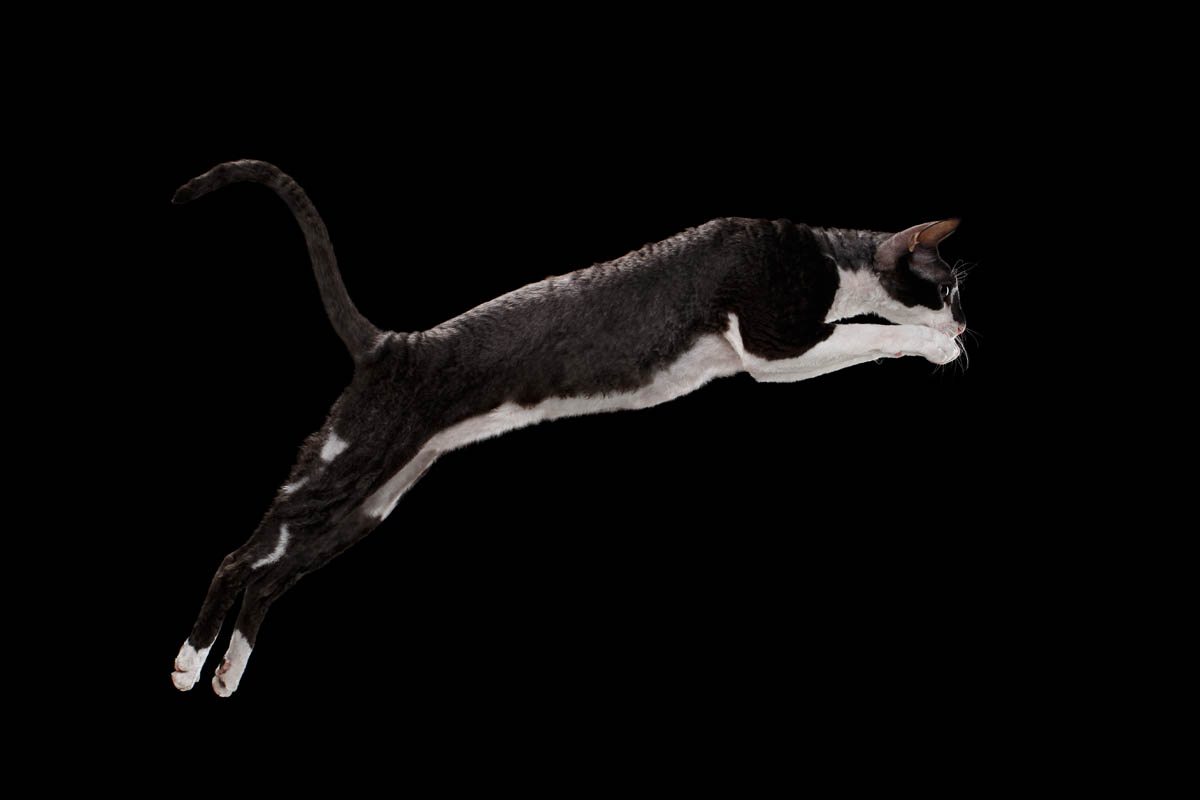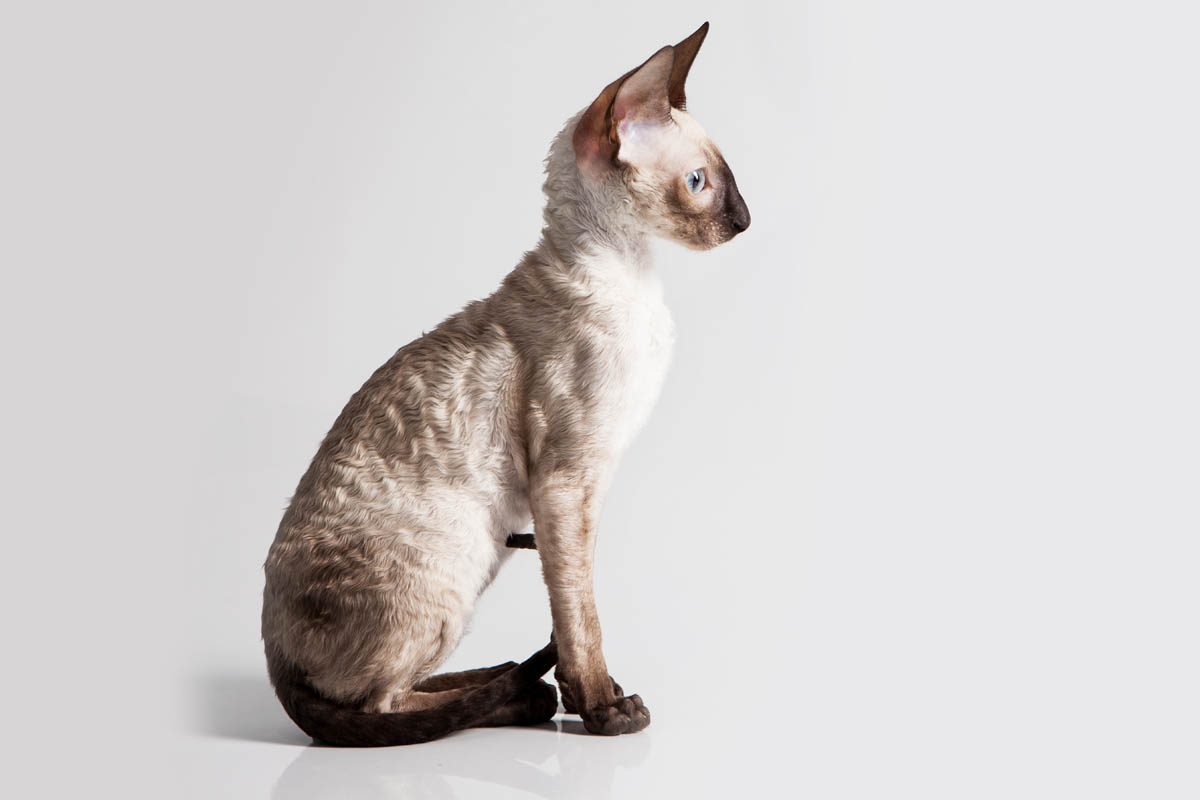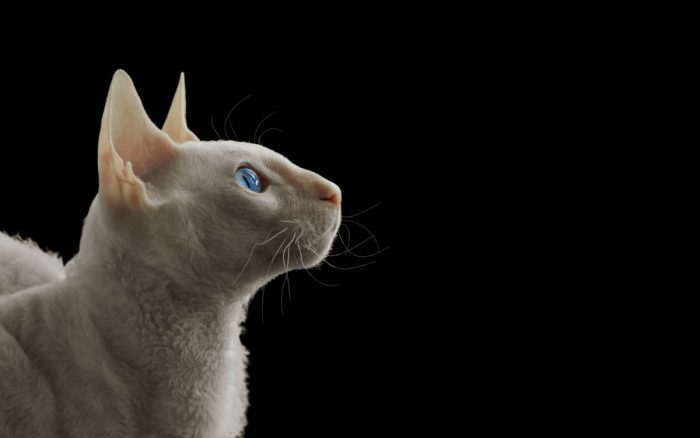At a glance
|
About

The Cornish Rex is a curly-coated domestic breed of cat who came about as a spontaneous mutation in Cornwall, England.
They are a friendly, outgoing and active breed of cat who gets along with children and other pets and make a great family companion.
History

The story of the Cornish Rex begins in Bodmin Moor, Cornwall. On 21st July 1950, a tortoiseshell cat by the name of Serena and owned by Mrs Nina Ennismore gave birth to a litter of five kittens. One red and white coloured kitten in this litter had an unusual curly coat. The kitten was named Kallibunker (Kalli)and was to become the founder of the Cornish Rex breed
Nina Ennismore’s veterinarian suggested she contact geneticist A C Jude. He advised she mate Kallibunker back to his mother. This mating produced three kittens. A straight coated female and two curly-coated males. Sadly, one of the males died at seven months of age, but the second male named Poldhu (along with Kallibunker) went on to sire further litters. The early Cornish Rexes were outcrossed to domestic cats.
This is where the history of the breed temporarily splits.
Cornish Rex in the UK
Sadly in 1956 due to financial costs and a large population of 40 cats, Nina Ennismore had a number of her cats put to sleep, including Kallibunker and his mother, Serena.
By the late 1950s, Nina Ennismore had stopped breeding Cornish Rexes. Brian Sterling-Webb continued to work with the breed. By this time, there were only two male Cornish Rexes left in Britain. One of whom was Poldhu. He was a tortoiseshell blue-cream-and-white male. This is rare in males, and when it does occur, they are almost always sterile. A veterinarian took a tissue sample from Poldhu for research. Unfortunately, he was accidentally castrated. Ironically, the tissue samples taken from Poldhu were lost. It is now believed that Poldhu was a chimera.
This left one remaining male Cornish Rex in Britain, Sham Pain Chas. Due to heavy outcrossing, the Cornish was losing its slender type. The great-great-great-grandson of Kallibunker, a blue boy by the name of Rio Vista Kismet and bred by Miss Jeanne Jeffrey of Calgary, was imported from Canada by Mrs Alison Ashford. Kismet managed to enable breeders to bring back the Cornish Rex to its original slender type.
In 1960 to celebrate ten years of the Cornish Rex The Daily Mirror ran an article on the breed, with a photo of a winking kitten. The article said that the kitten (Du-Bu Lambtex) was the only curly coated kitten in Britain. A lady by the name of Miss Beryl Cox contacted the paper to say that she too had a curly-coated cat named Kirlee. Believing that Kirlee also carried the Cornish Rex gene, Brian Sterling-Webb arranged for Kirlee to be sent to Cornwall to be a part of the breeding programme.
When mated to several Cornish Rex females the offspring came out straight coated. It was concluded that Kirlee’s mutation was different from that of the Cornish Rex and the two recessive genes were named: Gene 1 (Cornish Rex) and Gene 2 (Devon Rex).
Cornish Rex in the USA
In 1956, Life magazine published an article on Cornish Rexes which generated much worldwide attention and the following year Frances Blancheri of California imported Lamorna Cove who was pregnant by her father Poldhu at the time. She went on to have a litter of 4 kittens.
I will finish with a quick timeline of the Cornish Rex history.
- 1948: Serena born
- 1950: 21st July, Kallibunker born
- Early 1952, Mrs Ennismore talks to her veterinarian about Kallibunker, who advises her to contact A C Jude
- July 1952: A C Jude publishes an article on the Rex.
- 1952: 27th August, Poldhu (Kallibunker’s son) is born.
- 1954: 15th August, Lamorna Cove is born.
- 1955: 5th June, Champagne Chas is born. He is the half-brother of Lamorna Cove and is Cream and White.
- 1956: Kallibunker and Serene are euthanised.
- 1956: Brian Sterling-Webb purchases Champagne Chas.
- 1957: Lamorna Cove, who is pregnant at the time, and a sibling are sent to the USA.
- 1957: February-Our Cats notes that A C Jude’s article which was published in Our Cats in 1952, has been published in the Journal of Genetics.
- 1959: Brian Stirling-Webb founded the Rex Coated and Any Other Variety Club.
- 1959: September. Kirlee (Devon Rex) is born but is unknown at this time.
- 1965: Mrs Alison Ashford imports Rio Vista Kismet from Canada to the UK.
- 1965: Brian Sterling-Webb dies.
- 1967: Rex Cat Club is founded.
Appearance

The Cornish Rex is a medium-sized cat with a muscular body and fine bones. Legs are long and oval paws are small.
The wedge-shaped head is longer than it is wide, with high cheekbones, oval eyes, a Roman nose and a strong chin. Ears are set high on the head, but should not be too close.
The coat is wavy (Marcel wave) in appearance with curly whiskers and eyebrows. A typical cat has three types of hair, guard hairs, awn hairs and down hairs (the undercoat). The Cornish Rex coat completely lacks the guard hairs, with the awn and down hairs giving the coat an incredibly soft feel.
The Cornish Rex comes in all recognised coat colours and patterns.
Temperament
The Cornish Rex is a quiet, outgoing and active cat, their friendly disposition means they like to be a part of the family and don’t like to be left out of day to day life.
Cornish Rex cats have a high energy level and love to play well into adulthood. They are an acrobatic breed who like to be up high.
Cornish Rexes are extremely intelligent cats and very affectionate, they get along with other pets and children.
Health
All cats have health problems; although the Cornish Rex is generally a healthy breed, they can have a higher incidence of the following:
- Hypertrophic cardiomyopathy
- Hypothyroidism
- Sunburn
Suitable for
Households who have the time to spend with the Cornish Rex including plenty of play and attention. Cornish Rexes thrive on company and get along exceptionally well with children and other pets.
Frequently asked questions
Are Cornish Rex cats hypoallergenic?
In truth, a rex cat is no different from any other cat and produces allergen like all other cats. They are not hypoallergenic by any means, as claimed by some. Then why do some people seem to have no allergic reaction to rex cats? One possible hypothesis is that as rex cats have less hair to shed, they simply deposit less allergen-laced hair around the home. But, whatever the reasons some allergic people seem to tolerate them.
Please, before you race out and look for a rex cat, remember you should always test your allergies by visiting home or catteries that only own rex cats, and test continuously over several weeks or months.
Do Cornish Rex cats shed?
Cornish Rex cats do shed, however, as they have less fur than other cats, there is less fur in the environment.
Where can I buy a Cornish Rex?
The Cornish Rex should be purchased from a registered cat breeder. This means they are registered with one of the cat councils such as the Cat Fanciers Association or The International Cat Association, have a prefix (cattery name), and litters are registered. The breeder should provide you with a pedigree for the cat you have purchased.
Can Cornish Rex cats be left alone?
Yes, but because of their people-loving nature, not for extended periods. If you are out of the house for long hours, consider a second cat for company.
What is the difference between the Cornish Rex and the Devon Rex?
The coat of the Cornish Rex is made up of awn and down hairs but has no guard hair, this makes the Cornish Rex coat soft to the touch. The wave-like pattern of the Cornish Rex is known as a Marcel Wave, which was a stylish waved hairstyle popular in the 1920s and ’30s, named after Francois Marcel, a French hairdresser who invented the process.
In addition to the awn and down hairs, the Devon also has sparse guard hairs, which are short and rexed compared to normal-coated cats. Devon Rex coats are looser with a more open curl compared to the waved coat of the Cornish Rex.

Do Cornish Rex cats need a bath?
Yes, Cornish Rex cats will need a weekly bath as sebum can build-up due to less hair to absorb this oily substance.

